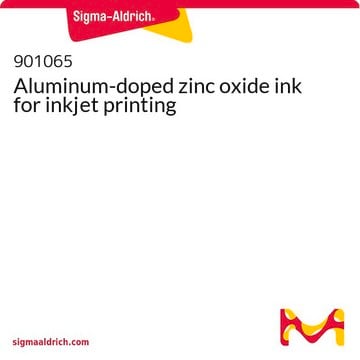739316
PEDOT:PSS
conductive inkjet ink, 0.8% aqueous dispersion
Synonim(y):
Orgacon™ IJ-1005, PEDOT:PSS, Poly(2,3-dihydrothieno-1,4-dioxin)-poly(styrenesulfonate)
About This Item
Polecane produkty
product name
Poly(3,4-ethylenedioxythiophene)-poly(styrenesulfonate), 0.8% in H2O, conductive inkjet ink
Postać
liquid
zawiera
1-5% Ethanol
5-10% Diethylene glycol
charakterystyka ekologicznej alternatywy
Design for Energy Efficiency
Learn more about the Principles of Green Chemistry.
sustainability
Greener Alternative Product
stężenie
0.8% in H2O
opór arkusza
110 Ω/sq
współczynnik refrakcji
n20/D 1.340
pH
1.5-2.5
lepkość
7-12 cP(22 °C)
gęstość
0.985 g/mL at 25 °C
kategoria ekologicznej alternatywy
, Enabling
temp. przechowywania
2-8°C
Szukasz podobnych produktów? Odwiedź Przewodnik dotyczący porównywania produktów
Powiązane kategorie
Opis ogólny
PEDOT:PSS has high electrical conductivity and good oxidation resistance, the properties which make it suitable for electromagnetic shielding and noise suppression. Thus, the polymeric film formed possesses high transparency throughout the visible light spectrum and even in near IR and near UV regions, displaying virtually 100% absorption from 900-2,000 nm. No absorption maximum from 400-800 nm was observed.
Zastosowanie
Informacje prawne
Kod klasy składowania
10 - Combustible liquids
Klasa zagrożenia wodnego (WGK)
WGK 2
Temperatura zapłonu (°F)
Not applicable
Temperatura zapłonu (°C)
Not applicable
Certyfikaty analizy (CoA)
Poszukaj Certyfikaty analizy (CoA), wpisując numer partii/serii produktów. Numery serii i partii można znaleźć na etykiecie produktu po słowach „seria” lub „partia”.
Masz już ten produkt?
Dokumenty związane z niedawno zakupionymi produktami zostały zamieszczone w Bibliotece dokumentów.
Klienci oglądali również te produkty
Produkty
A detailed article on conducting polymer materials for flexible organic photovoltaics (OPVs) applications.
In the field of organic printable electronics, such as OLEDs and organic photovoltaics (OPVs), improved organic conducting and semiconducting materials are needed. The progress in two fields is reviewed in this article.
Conducting polymers such as polyaniline, polythiophene and polyfluorenes are now much in the spotlight for their applications in organic electronics and optoelectronics.
Advancements in bioelectronics, incorporating self-healing materials for wearable devices, and measuring bioelectric signals to assess physiological parameters.
Nasz zespół naukowców ma doświadczenie we wszystkich obszarach badań, w tym w naukach przyrodniczych, materiałoznawstwie, syntezie chemicznej, chromatografii, analityce i wielu innych dziedzinach.
Skontaktuj się z zespołem ds. pomocy technicznej





